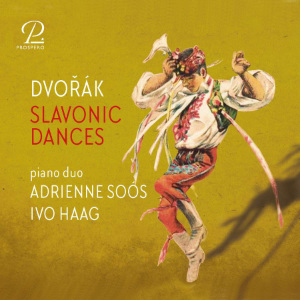
Antonin Dvořák (1841-1904)
Slavonic Dances op.46 (for piano four hands)
Slavonic Dances op.72 (for piano four hands)
Adrienne Soós and Ivo Haag (piano duo)
rec. 2021, Studio Zürich, Switzerland
Prospero PROSP0047 [69]
The young composer Antonin Dvořák skyrocketed to international fame with the publication of his first set of eight Slavonic Dances for four-hand piano, op.46. These were soon followed by Dvořák’s orchestral arrangement of the dances, which is how they are best known today. They were followed in 1886 by a second set of eight dances, op.72, in both piano four hands and orchestral versions. While largely supplanted by the orchestral arrangements, the original form of these delightful pieces is nevertheless highly rewarding. Dvořák takes particular care in making sure the secondo part, all too often an afterthought, has plenty of interesting things to do, and frequently gives it the melody, or splits it with the primo part.
Although popular, these works are something of a bête noire for ethnomusicologists, for unlike Brahms and Liszt before him, and Bartók after him, Dvořák merely used the rhythms and forms of Czech folk dances; the actual melodies are his own inventions. Dvořák made no claim that they were authentic, but they sound so convincing that they are often confused with the genuine article by laymen. Widely varied in style, the Dances have an impact that is highly alluring to your inner Romantic Slav, if you have one.
This recording of the sixteen dances in the two sets by Adrienne Soós and Ivo Haag on Bösendorfer pianos does Dvořák proud, with a vibrancy and moving quality that is highly appropriate. By turns festive, mournful, romantic, proud and jubilant, the dances are played with an incredibly accurate precision such that it is very difficult to tell where one player’s hands end and the other begins. The balance is also carefully measured to amplify that effect, while always taking care not to bury the melody in the often roiling action above and below.
Particular highlights of this recording were the bombast in op.46/1, and the very exciting rendition of op.46/5, culminating in an exhilarating Presto. The rustic minuet of op.46/4 with its sprightly-dancing grace notes is set off against the melody deftly passing from one player to the other without any interruption or distinction of touch. This is clearly a piano duo on precisely the same wavelength. The delightfully off-kilter Presto of op.46/8 pairs a 2/4 theme against a three-count accompaniment with always surprising results.
In the second set, op.72, the first dance is joyous and triumphant. It signals that this set is a very worthy successor to the first, and the duo provides excellent contrast in the haunting B-minor middle section. Op.72/3 is breathtaking in its wonderful sweeping motifs. The final dance does not end with the bang found on its equivalent in the first set, but sadly seems to indicate that there will be no more of these little works from Dvořák’s pen.
The one instance where I did not much care for Soós and Haag’s choices was in op.46/2; the Allegretto scherzandoand the Allegro vivo should to my mind have more of a contrast; there just didn’t seem to be enough difference between the two tempi to be satisfying. It also should be noted that they follow the usual ordering of the orchestral version, swapping into the third position of op.46 the Polka in A-flat major with the Sousedská in D major that appears in the sixth position here. Since most listeners will be familiar with this ordering from hearing the orchestral arrangement, it probably is less jarring, but the ordering in the first edition with these two dances reversed appears to have been approved by the composer. On the positive side, the performers observe each and every repeat sign indicated by Dvořák, maximizing the pleasure.
The engineering of this disc is first-rate. The sound is clear and vibrant, with excellent dynamic range. Crescendi are rendered appropriately. Dvořák makes full use of the keyboard, so you would be well advised to listen to this recording either with large speakers with a good woofer or on high-quality headphones. There is a lot of low-range information to be heard in this recording.
The included booklet contains useful background information about the works and the performers in German, English, and French.
This recording may not supplant that by Katia and Marielle Labèque on the Philips label, but it is certainly a worthy alternative.
Mark S. Zimmer
Help us financially by purchasing from





















